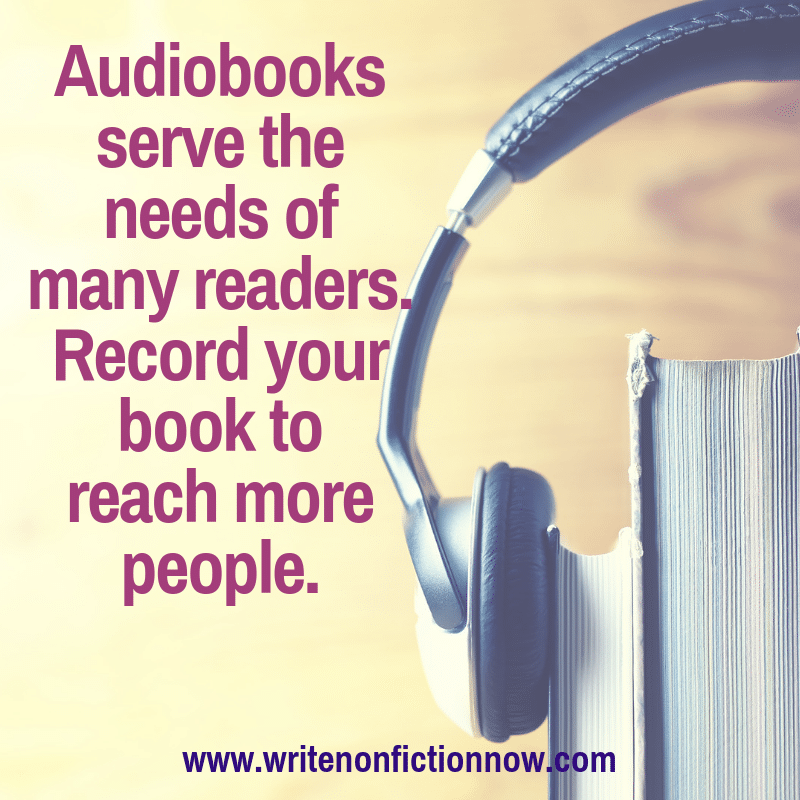Historically, books came in the form of bound and printed texts. Now, however, you can find books in different mediums, like ebooks and audiobooks. And when someone tells you what book they currently are reading, more often than not they aren’t reading—they are listening to an audiobook.
In May 2018, Forbes reported that, according to the American Association of Publishers, digital audiobook revenue rose 32.1% in 2018’s first quarter. Adam Rowe wrote, “It’s the continuation of a well-documented trend: Audiobook sales grew around 20% year over year across the first eight months of 2017, according to AAP data. Audiobooks now earn publishers more than mass market paperbacks — even as ebook sales fell 3.2% in 2018’s first quarter.”
The statistics tell a good part of the story. The popularity of audiobooks is increasing, and people are listening to them whenever they can find the time. They listen to books while cooking, commuting, walking, jogging, etc. Therefore, you want to put your work before the wide range of audiences who like to listen rather than to read.
Why create an audiobook?
There are a variety of reasons to create an audiobook. First, while millions of books and ebooks have been published, the number of audiobooks available is comparatively fewer. Therefore, with this medium gives you a better chance of ranking high among those available in your book’s category. A higher rank can get you more sales.
There is also an ever-growing global market for audiobooks. If your book can be promoted and sustained in two or more mediums, it behooves you to do so and gain market share in the US and abroad.
How to Begin Creating an Audiobook
The initial step in any endeavor, such as writing a book, is the most difficult one. Publishing your book is the first step. Once you have your book published, you can take another step and create an audiobook.
If you have self-published your book, you have the rights to produce an audiobook. If you traditionally published, you may need to do so through your publishing house—and check on who holds the rights to that audiobook.
If you are the publisher of your book, you might be wondering how to create and publish my own audiobook. You might also have questions about the expense involved and how to market the audiobook once released.
No matter how you approach the project, keep one rule forefront: You must have quality audio. Quality matters. And quality tends to cost.
Two ways to Create an Audiobook
There are two ways to create an audiobook:
- Pay for production
- Do it yourself (DIY)
For both these options, you need to have an account on ACX (Audiobook Creation Exchange). This service provides an interface where you can find a lot of narrators and producers who create audiobooks. And the audiobooks can be sold and uploaded on Amazon, Audible, and Itunes. Via this account, if you want to pay for production for the audiobook, you can hire professionals—like narrators—to help you.
And you have options for how to pay these professionals, including:
- Pay for a flat hourly rate
- Share the revenue of the audiobook sales (also known as royalty payments)
Let me explain each one of the payment options.
Flat hourly rate:
Here you directly pay to the narrator of the audiobook a flat hourly rate, e.g., $40 for the recording of one-hour audio. This can range between $35 to $350 an hour.
Just because a narrator charges more, he is not necessarily a good narrator or the right one for your book. You have to select your narrator based on your book, audience, and budget.
Additionally, There could be additional post editing and correction charges for the audio.
Revenue sharing:
Some narrators like to share the revenue of the audiobook rather than get paid a flat fee. This could mean they negotiate 20% to 50% of all revenue produced by sales of the finished product. You pay nothing upfront but lose income on an ongoing basis as the book sells. This is the same as using a royalty model. Like the author, they get paid royalties.
So, you can hand pick your narrator according to your budget.
Record your own Audiobook
The DIY-approach to creating an audiobook can prove challenging for some people. Yet, by recording your audiobook in your own voice, you allow a different type of connection with your readers. The audience enjoys listening to the author of the book read her own work. Plus, they can relate to your emotion and feelings due to the tone of voice vocalizing the words on the page.
Technical Equipment Required for Recording
Of course, you need the right equipment to record your own audiobook. The technical equipment required includes:
- A good computer with a USB port
- A good microphone ($100)
- A pop filter ($5 to $10)
- Software for recording (Audacity for PCs and Garageband for Mac)
Once again, keep in mind that quality matters. Also, your audio must meet the standards expected for ACX submission.
Self-Recording Tips
Here are a few things to keep in mind while self-recording:
- Each audio file should not be more than 120 minutes long.
- Each chapter should be recorded separately in different files.
- Record an opening and closing that include your credentials.
- Record an introduction to the audiobook.
- Record an overview of the audiobook.
The space in which you record is enormously important as well. It needs to have enough sound absorbers like carpet, curtains, and furniture, so sound does not “bounce” or the recording ends up sounding like there is an echo or you are in an empty box.
You also want to eliminate the sounds from the fans, air conditioners, and mobile phones if they are in close proximity to your recording space.
What then? Read your book. Imagine you are reading to your customer Avatar or the description of your ideal reader. Read to the person for whom you wrote the book.
Then upload your files to ACX, and start marketing your new audiobook.
Have you created an audiobook? Tell me about your experience and offer your tips in a comment below.
About the Author
 Nishil Prasad is a passionate writer, hungry for new innovation. New trends fill him with tons of enthusiasm to uncover hidden topics. Speakaudible covers a wide range of subjects related to audiobooks.
Nishil Prasad is a passionate writer, hungry for new innovation. New trends fill him with tons of enthusiasm to uncover hidden topics. Speakaudible covers a wide range of subjects related to audiobooks.

Tom says
How do you feel about text to speech audio books? Once you listen through it, there is a way to correct how you want certain things to pronounce if it is not done properly through automation. I use it to turn my blog into a podcast, and it is certainly an enjoyable listen.
Nina Amir says
I would read the content aloud and not rely on a text-to-speech software, which sounds automated.
Nishil says
Hi Tom,
Sounds like a nice tip will surely try it out.
Regards
Nishil